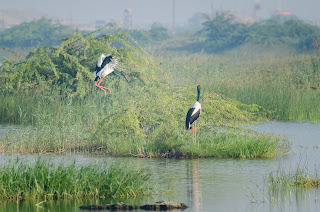This is a wetland area near historical city,
The Black necked stork is
found all over Indian plains common nowhere but widespread. It is also seen
regularly on costal wetlands and mangrove swamps, and even breeds on tall
mangrove in
In
our team visited a small but very rich bird sanctuary and surrounding wetlands frequently and picturesd the nesting behavior of a near threatened Black Necked Stork during August to February.
During their breeding period in the peak of monsoon they have dance like display. The pair talk up to each other, extending their wings process occurs on the nest they have initiated. Copulation continues for around two or three weeks. The nest is large made up of sticks, branches and lined up with rushes, water plants and sometime with a mud plaster on the edges. The nest may be reused year after year secluded part of large marshes. Eggs are laid and the incubation is shared by both bird.
Black
necked stork is 1.3 mtr. Tall bird having a wingspan of arroud 2 meters with a
huge long black bill and a short tail. Weight of adult bird is near 4 to 4.5
k.g. recorded. The body is white with black contrasting wings. Head and neck
are bluish black with shiny green and purple gloss. The crown is coppery brown.
The male has a dark brown iris where as
the female has a yellow. They keep on preening their feathers which is one of
their major activity. The life
Based on details field and literature survery by Mr. Asad Rahmani, a
well known researcher total 141 sightings in 11 states were noted in
Late Shri Dharamkumarrsinhji found black necked stork is to be not uncommon in Saurashtra region written by Mr. Rahmani.
The incubation period is
around 30 to 35 days, two chicks are born tooks one month old chicks born with
white down now is replaced by darker grey down within a week.
A growing chicks can now stand on their feet.
They play with each other and clatters their bills.
One adult remains at the
nest with chicks for warmth and protection from predators flying around nesting
site.
The other bird take a turn
at the nest to relieve the other.
It has come with a food and water collected in its large beck. And pours water on chicks and on the sticks around to cool them and the nest to relieve from the heat and feeds chicks with fishes.
Now
chicks are grown up fast, healthy and active. Adults stops feeding chicks after
they are 3 to 4 months old and shows aggression towards them is find food by
themselves. In Khijadiya bird sanctuary and surrounding wetlands the forest
Department has well protected the nesting sites of Black necked stork since
many years. Resulted in increase of their populations in not only Khijadiya
bird sanctuary but surrounding wetlands of
Chicks remain with their parents for six months and have mottled appearance especially on head and neck.
This species is declining in
most part of
Learns the foraging skills
performed by their parents. The nesting period is three to four months and
juveniles stay with the parents till the next breeding season.
Visit and subscribe my you tube channel, and view the full documentation of nesting behaviour of black necked stork.
https://www.youtube.com/watch?v=U_cvBJvI6j0
https://www.youtube.com/watch?v=U_cvBJvI6j0









Comments
Post a Comment